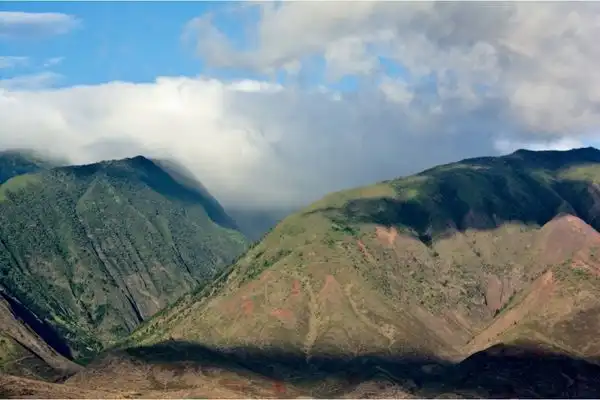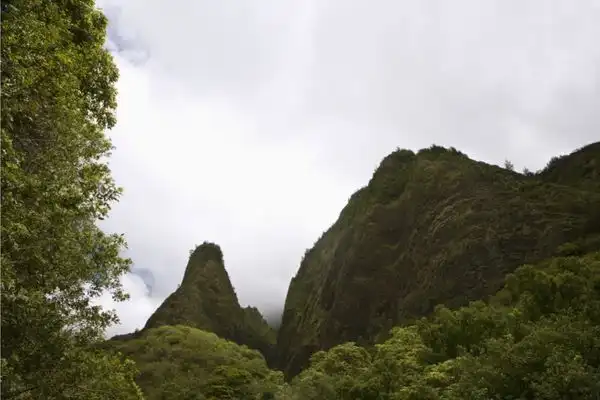The West Maui Mountains tower over the resorts of Ka’anapali and the city of Lahaina.
Covered in greenery and incredibly difficult to traverse, these ancient mountains are the result of volcanic eruptions molded by wind and rain.
Learn about the West Maui Mountains, and how you can explore them, with our complete guide.

What Are The West Maui Mountains?
Table of Contents
Maui is an island formed by two major volcanic eruptions, and those eruptions are what gives the island its distinctive two-part shape.
The bulk of Maui is formed by Haleakala. A still active volcano, although the last eruption was in 1790, the slopes of Haleakala make up East Maui, the North Shore, and the Upcountry.
So, what about the other volcano? The second major volcano that formed Maui is the older volcano, and the eruptions and subsequent erosion are what formed the West Maui Mountains.
Major volcanic activity in the West Maui Mountains occurred between 500,000 and 320,000 years ago, giving West Maui its shape. However, the volcano is thought to be as much as 1.7 million years old. It’s now extinct.
As a side note, Maui County includes Lanai, Kaho’olawe, and most of Moloka’i. All these islands were formed by volcanic eruptions, and were once attached to Maui!
And in about 15,000 years, West Maui and Haleakala will likely drift apart.
The Landscape Of The West Maui Mountains
The West Maui Mountains lack the height and sweeping space of Haleakala. This is a much older formation, one that has been cut away and eroded by hundreds of thousands of years of wind, rain, and sea.
The shield volcano that forms the West Maui mountains has long been extinct, and in the ensuing years, natural erosion has caused the West Maui Mountains to develop a rugged landscape.
The highest point of the West Maui Mountains is Pu’u Kukui. Stretching up to 5,788 foot, Pu’u Kukui is only around half the height of 10,000 foot Haleakala.
It overlooks a natural reserve area, where many plants endemic to the island (and even to the mountains themselves) can be found.
Most of the mountains are dominated by knife-edged valleys, deep gorges, and powerful streams. Covered in luscious growth, the western areas were (and still partly are) home to many ranches and farms.
To the south, the mountains turn arid, and the verdant valleys become dry slopes.
What Are The West Maui Mountains Called?
The West Maui Mountains are most frequently referred to simply as the West Maui Mountains. However, they have also been given the name Mauna Kahalawai, which translates to “holding house of water”.
Can You Drive The West Maui Mountains?
Driving between the slopes of a volcano and the crashing waves of the sea is actually a fairly common pastime on Maui: the Road to Hana is close to the top of almost every visitor to-do list.
There is also a road winding along the north and eastern edges of the West Maui mountains. A journey along the Kahekili Highway (Hwy 340) includes panoramic ocean views, gulches, valleys, and even waterfalls.
It all sounds pretty good, right? But there is one major downside: the Kahekili Highway is widely considered to be one of the most dangerous roads on Maui.
Balanced between towering mountain slopes and powerful seas, blind turns and one-lane passes make for a tough drive.
If you do intend to drive the Kahekili Highway, we recommend setting out early, to avoid the worst of the traffic and the rain showers that are common in the afternoon.
Take the road carefully, and make use of the stopping places along the way.

Things To Do In The West Maui Mountains
Visit ‘Iao Needle State Monument
Undoubtedly the most famous landmark of the West Maui Mountains, the ‘Iao Needle is a towering rock outcrop tucked deep into the mountains.
Formed by centuries of erosion, the ‘Iao Needle is a sacred place for Native Hawaiians.
With a relatively easy hike to some incredible views, a visit to the ‘Iao Needle is one of the best ways to discover the West Maui Mountains.
Stop At Kahakuloa Bay
It can be a bit of a surprise to come across Kahakuloa, a (very) small town on the north side of the West Maui Mountains. Hidden among the ridges of the mountains, it’s a tough place to get to!
You need to navigate the one-lane section of Kahekili Highway, or prepare for a walk.
The occasional food truck and a pretty church add to the scenic views that draw most visitors, but getting to Kahakuloa can be a nightmare.
Hike The Trails
Many parts of the West Maui Mountains are completely impossible to navigate by foot—that’s what a million years of volcanic eruptions and erosion will get you.
However, there are a few trails which reward dedicated hikers with breathtaking views across the mountains. Try the Waihee Ridge Trail, for a relatively accessible climb and peak viewing points.
Tour The Coastal Areas
The coastal areas of West Maui were created by the same volcanic eruptions that formed the mountains themselves, and you can see evidence of the volcanic past across the coast.
Visit the Dragon’s Teeth to see what happens when cooled lava reaches the crashing sea waves. Or for something a little easier, take in Black Rock at Ka’anapali. It’s the result of one of the last lava flows in the area.
Take A Helicopter Tour
If you have the time, and the money, the best method for taking in the epic landscape of the West Maui Mountains is by air.
Helicopter tours offer a bird’s eye view of the wild contours that are hidden for most visitors, including a glimpse at the epic waterfalls that are otherwise completely inaccessible.
Final Thoughts
The West Maui Mountains were first formed over a million years ago, with eruptions and erosion providing the landscape with towering peaks and cliffs.
Difficult to tour by foot or car, a few hiking trails offer visitors a glimpse at the impressive topography of the West Maui Mountains.
